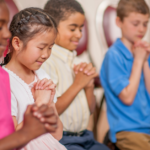As a Sunday school teacher and parent, I’ve seen firsthand the transformative power of introducing children to Christian meditation. It’s a beautiful journey that starts with tiny seeds of faith and blossoms into a deep, lifelong connection with God.
Understanding the Foundations
Christian meditation for children is rooted in the same principles as adult meditation but tailored to suit young minds. It creates a space for children to connect with God, reflect on His word, and experience His love tangibly.
The theoretical background draws from both spiritual traditions and child development research. Children learn best through multisensory experiences, storytelling, and play.
By incorporating these elements into meditation practices, we make spiritual exercises more engaging and effective for young ones.
Christian meditation for children can take many forms:
- Guided visualizations of Bible stories
- Breath prayers using simple phrases
- Body prayer movements
- Contemplative coloring of Scripture verses
- Nature walks focusing on God’s creation
One of the main challenges in introducing meditation to children is their naturally short attention spans. To overcome this, we keep sessions brief, usually 2-5 minutes for younger children and 5-10 minutes for older ones.
We also incorporate movement and tactile elements to help kids stay engaged.
Implementing Christian Meditation for Kids: A Step-by-Step Approach
1. Create a Sacred Space
Designate a quiet corner in your home or classroom. Add a children’s Bible, a cross, or other meaningful symbols.
This physical space helps children transition into a prayerful mindset.
2. Start with Centering
Begin each session with a simple centering exercise. Have children take three deep breaths, imagining they’re breathing in God’s love and breathing out any worries.
This helps them settle and focus.
3. Choose a Focus
Select a short Bible verse, story, or theme for the meditation. For example, “God is love” (1 John 4:8) or the story of Jesus calming the storm.
Keep it simple and age-appropriate.
4. Guide the Meditation
Use age-appropriate language to lead children through the meditation. For younger kids, this might involve imagining they’re in the Bible story.
For older children, it could be reflecting on what a verse means in their lives.
Here’s an example of a guided meditation for younger children based on Psalm 23:
*Close your eyes and imagine you’re a little sheep. You’re in a beautiful green meadow with soft grass under your feet.
The sun is warm on your back.
You can hear a gentle stream nearby. Your shepherd, Jesus, is with you.
He leads you to the cool water to drink.
You feel safe and loved. Jesus watches over you and protects you. Take a moment to enjoy being in this peaceful place with Jesus.*
5. Incorporate Movement
Include gentle movements or stretches that relate to the theme. For instance, “reaching up to receive God’s love” or “giving a hug to share God’s love.” This helps kinesthetic learners engage more fully.
6. Close with Gratitude
End each session by encouraging children to share something they’re thankful for. This cultivates a habit of gratitude and helps children recognize God’s blessings in their lives.
7. Reflect and Share
Allow time for children to draw, journal, or share their experiences verbally. This helps solidify the experience and allows for personal application.
Common Pitfalls and How to Avoid Them
Forcing Participation
Some children may resist sitting still or closing their eyes. Offer alternatives like keeping eyes open or holding a special object.
The goal is to make meditation inviting, not intimidating.
Using Complex Language
Keep instructions and guided meditations simple and concrete. Use words and concepts that children can easily understand and relate to.
Neglecting Physical Needs
Ensure children are comfortable and not hungry or thirsty before starting. Physical discomfort can be a major distraction during meditation.
Inconsistency
Regular practice is key. Aim for short, frequent sessions rather than long, infrequent ones.
Even a daily one-minute meditation can have a significant impact over time.
Ignoring Individual Differences
Be flexible and adapt practices to suit different learning styles and temperaments. Some children may prefer silent reflection, while others might engage better with active prayer movements.
Adapting Christian Meditation for Different Scenarios
For Active Children
Incorporate more movement, like “prayer walks” or acting out Bible stories. You might have children walk around the room, stopping at different “prayer stations” to reflect on different aspects of God’s character.
For Visual Learners
Use pictures, videos, or objects to illustrate meditation themes. For example, when meditating on God’s protection, you could show images of a mother bird sheltering her chicks under her wings.
For Auditory Learners
Include music or sound effects in guided meditations. Gentle background music or nature sounds can help create a peaceful atmosphere and aid concentration.
For Kinesthetic Learners
Provide tactile prayer objects like smooth stones or prayer beads. Children can hold these objects as they pray or use them to count blessings or recite short prayers.
For Group Settings
Use partner or small group activities to encourage interaction and sharing. For example, children could work in pairs to create a “gratitude collage” using magazine cutouts.
Building on Basics for Deeper Spiritual Growth
As children grow more comfortable with basic meditation practices, you can introduce more advanced concepts:
Lectio Divina
Teach older children this ancient practice of praying with Scripture. Here’s a simplified version:
- Read: Choose a short Bible passage and read it slowly.
- Reflect: Think about what the passage means.
- Respond: Talk to God about what you’ve read.
- Rest: Sit quietly in God’s presence.
Contemplative Prayer
Guide teens in sitting silently in God’s presence. Start with short periods (1-2 minutes) and gradually increase the duration as they become more comfortable.
Ignatian Examen
Help children reflect on their day and notice God’s presence in it. This can be done before bedtime using these simple steps:
- Thank God for something good that happened today.
- Think about how you felt during the day.
- Remember a time when you made a good choice.
- Remember a time when you made a not-so-good choice.
- Ask God to help you tomorrow.
Fasting and Meditation
For older teens, introduce the concept of combining fasting with meditation for deeper spiritual experiences. This could be as simple as skipping one meal and using that time for prayer and reflection.
Exercises to Reinforce Learning
Bible Verse Memory Game
Create cards with short verses and have children meditate on one each day, then try to recall them at the end of the week. Make it fun by turning it into a matching game or a treasure hunt.
Gratitude Journal
Encourage children to write or draw three things they’re thankful for each day. Younger children can dictate their thoughts to an adult or draw pictures.
Meditation Scavenger Hunt
Hide objects around a room or outdoor space that relate to a Bible story or theme. Have children find them and reflect on their significance.
For example, for the story of Jesus calming the storm, you might hide a toy boat, a spray bottle (for water), and a pillow (Jesus was sleeping).
Create a Calm-Down Corner
Work with children to design a special space for prayer and meditation in their room. Let them choose comfy cushions, hang up their favorite Bible verses, or include a box of prayer prompts.
Family Meditation Challenge
Encourage families to practice a short meditation together daily for a month and share their experiences. Provide a simple guide or calendar to help them stay on track.
The Impact of Christian Meditation on Child Development
Introducing children to Christian meditation can have profound effects on their spiritual, emotional, and cognitive development. Here are some key benefits:
Spiritual Growth
Regular meditation helps children develop a personal relationship with God. It teaches them to listen for God’s voice and recognize His presence in their daily lives.
This foundation can lead to a lifelong faith that’s deeply rooted and personally meaningful.
Emotional Regulation
Christian meditation gives children tools to manage their emotions. By focusing on God’s love and peace, they learn to calm themselves in stressful situations.
This skill is invaluable as they navigate the challenges of growing up.
Improved Focus and Concentration
The practice of sitting still and focusing on a single thought or image helps develop attention skills. This can translate into better performance in school and other activities requiring concentration.
Enhanced Empathy and Compassion
Meditating on God’s love for all people can foster a sense of empathy in children. They learn to see others as God sees them, which can lead to more compassionate behavior towards peers and family members.
Stress Reduction
In our fast-paced world, even children experience stress. Christian meditation provides a way for them to slow down, relax, and release worries to God.
This can lead to better sleep, reduced anxiety, and an overall sense of well-being.
Positive Self-Image
Reflecting on their identity as beloved children of God helps kids develop a healthy self-image. They learn that their worth comes from God’s love, not from their achievements or others’ opinions.
Critical Thinking Skills
As children engage with Bible stories and verses through meditation, they learn to think deeply about spiritual truths. This can enhance their critical thinking skills and ability to apply Biblical principles to real-life situations.
Integrating Christian Meditation into Daily Life
To maximize the benefits of Christian meditation for children, it’s important to integrate it into daily life beyond formal practice times. Here are some ways to do this:
Morning Blessings
Start the day with a brief meditation or prayer. This could be as simple as saying, “Good morning, God! Thank you for this new day” while taking a few deep breaths.
Mealtime Reflections
Before meals, take a moment to reflect on God’s provision. Encourage children to share one thing they’re grateful for.
Bedtime Wind-Down
Incorporate a short meditation into the bedtime routine. This can help children relax and end the day on a positive note.
Nature Walks
Use time outdoors to practice awareness of God’s creation. Encourage children to notice the beauty around them and thank God for it.
Car Ride Prayers
Use time in the car for short prayers or meditations. This can turn potentially stressful travel time into a peaceful, connecting experience.
Emotion Check-Ins
When children are experiencing strong emotions, guide them to take a moment to breathe and remember God’s presence with them.
Family Devotions
Incorporate meditation into family devotion time. This can help children see meditation as a normal part of family spiritual life.
Creating a Supportive Environment
To help children embrace Christian meditation, it’s crucial to create a supportive environment both at home and in church settings. Here are some strategies:
Lead by Example
Let children see you practicing meditation and prayer. Share your experiences with them in age-appropriate ways.
Celebrate Efforts
Praise children for their tries at meditation, regardless of how “successful” they seem. The goal is to cultivate a habit, not achieve perfection.
Address Questions and Doubts
Be open to children’s questions about meditation and prayer. Use these as opportunities for deeper discussions about faith.
Involve the Whole Family
Make Christian meditation a family activity. This reinforces it’s importance and provides accountability and shared experiences.
Collaborate with Church Leaders
Work with Sunday school teachers and youth leaders to incorporate meditation into church programs. This provides consistency between home and church practices.
Create Resources
Develop or find age-appropriate resources like guided meditation scripts, prayer journals, or meditation-focused devotionals for children.
Foster a Non-Judgmental Atmosphere
Emphasize that there’s no “right” or “wrong” way to meditate. Each child’s experience with God is unique and valuable.
Overcoming Challenges
Even with the best intentions, you might come across challenges when introducing Christian meditation to children. Here are some common issues and strategies to address them:
Short Attention Spans
For children who struggle to sit still, start with very brief sessions (even just 30 seconds) and gradually increase the time. Use physical objects like holding a cross or squeezing a stress ball to help them focus.
Difficulty Visualizing
Some children may struggle with visualization exercises. Offer alternatives like drawing their thoughts about God or using tangible objects to represent spiritual concepts.
Lack of Interest
If a child seems uninterested, try different approaches. Maybe they prefer active prayer walks to sitting still, or perhaps they engage better with music-based meditations.
Giggles and Disruptions
It’s natural for children to sometimes get the giggles during quiet time. Don’t scold them – instead, thank the silliness and gently redirect their attention.
Expressing Doubts
If a child expresses doubt about whether God is listening or present, confirm their feelings. Share your own experiences of sensing God’s presence and encourage them to keep trying.
Inconsistency
Life can be busy, and it’s easy to let meditation practice slip. Create visual reminders like a family meditation calendar or a special alarm tone to help maintain consistency.
Peer Pressure
As children get older, they may feel self-conscious about practicing meditation, especially if their friends don’t. Encourage them to see it as a special skill they’re developing and perhaps teach them ways to practice discreetly.
Advanced Techniques for Older Children and Teens
As children grow and mature in their faith, you can introduce more advanced Christian meditation techniques. These practices can help deepen their spiritual lives and provide tools for navigating the challenges of adolescence:
Centering Prayer
Teach teens this form of contemplative prayer where they choose a sacred word as a symbol of their intention to consent to God’s presence and action within. They sit quietly for a set time, gently returning to the sacred word when thoughts arise.
Imaginative Prayer
Guide older children through Ignatian contemplation, where they use their imagination to enter into a Gospel scene. Encourage them to engage all their senses and interact with Jesus in the story.
Breath Prayer
Introduce the concept of repeating a short prayer phrase in rhythm with the breath. For example, inhaling on “Jesus Christ” and exhaling on “have mercy on me.”
Lectio Divina Journaling
Combine the practice of Lectio Divina with journaling. After reading and reflecting on a Scripture passage, have teens write their thoughts, prayers, and any messages they feel God is speaking to them.
Body Prayer
Teach teens to use their entire body in prayer through practices like prayer labyrinths, prayer postures, or even Christian yoga adapted for worship.
Fasting and Meditation Retreats
For mature teens, consider organizing short fasting and meditation retreats. These can be powerful experiences of drawing close to God and hearing His voice more clearly.
Service Meditation
Combine meditation with acts of service. Before a service project, have teens meditate on relevant Scripture.
After serving, guide them in reflecting on where they saw God at work.
The Role of Technology in Christian Meditation for Kids
In our digital age, technology can be both a help and a hindrance to spiritual practices. Here’s how to navigate this:
Meditation Apps
There are several Christian meditation apps designed for children and teens. These can provide guided meditations, timers, and tracking features to encourage regular practice.
Online Communities
For older teens, online Christian communities focused on meditation and prayer can provide support and accountability.
Virtual Reality
Some churches and Christian organizations are exploring the use of VR for immersive Bible story experiences, which can be a form of meditative practice.
Digital Detox
Encourage periods of “digital detox” where children put away devices to focus on God without distractions.
Creation of Digital Content
Empower teens to create their own digital content related to Christian meditation, such as podcasts or YouTube videos, as a way of deepening their own practice and sharing with peers.
Measuring Progress and Celebrating Growth
While the fruits of Christian meditation are often intangible, there are ways to measure progress and celebrate growth:
Journaling
Encourage children to keep a simple prayer journal. Periodically review it together to notice patterns of growth.
Behavior Changes
Look for positive changes in behavior, such as increased patience, kindness, or ability to manage emotions.
Spiritual Conversations
Notice if children are initiating more conversations about God or showing increased interest in spiritual matters.
Feedback from Others
Teachers or other adults in the child’s life might notice positive changes. Celebrate these observations.
Self-Reflection
For older children, encourage periodic self-reflection on their spiritual journey. What changes have they noticed?
How has their relationship with God grown?
Meditation Milestones
Celebrate milestones like consistently meditating for a certain number of days or trying a new form of meditation.
Key Takeaways
- Christian meditation offers many benefits for children’s spiritual, emotional, and cognitive development.
- Christian meditation for children should be age-appropriate, engaging, and multisensory.
- Consistency and regularity are more important than length of practice.
- Adapt meditation techniques to suit different ages, learning styles, and person needs.
- Integrate meditation into daily life beyond formal practice times.
- Create a supportive environment that encourages questions and celebrates efforts.
- Be prepared to address challenges with patience and creativity.
- Introduce more advanced techniques as children grow and mature.
- Use technology wisely as a tool to support meditation practice.
- Measure progress and celebrate growth in tangible and intangible ways.
Frequently Asked Questions
How do I introduce Christian meditation to my child?
Start with short, simple exercises like taking three deep breaths while thinking about God’s love. Gradually introduce more structured practices as your child becomes comfortable.
At what age can children start practicing Christian meditation?
Children as young as 3 or 4 can begin with simple practices. Adjust the complexity and duration of meditation based on the child’s age and attention span.
Can Christian meditation help with my child’s anxiety?
Yes, Christian meditation can help children manage anxiety by teaching them to focus on God’s presence and love, rather than their worries.
How long should a child’s meditation session be?
For younger children (ages 3-7), start with 1-2 minutes. Older children (8-12) can usually manage 3-5 minutes.
Teens may be able to meditate for 5-10 minutes or longer.
What’s the difference between Christian meditation and mindfulness?
Christian meditation focuses on connecting with God and reflecting on His word, while mindfulness typically involves non-religious awareness of the present moment.
Can Christian meditation replace Bible study for kids?
No, Christian meditation should complement, not replace, Bible study. It’s a way to deepen understanding and application of Biblical truths.
How often should children practice Christian meditation?
Daily practice is ideal, even if it’s just for a minute or two. Consistency is more important than length.
Are there any risks associated with Christian meditation for children?
When practiced appropriately, Christian meditation is safe for children. However, be mindful of any signs of discomfort or distress and adjust practices accordingly.
Can Christian meditation help with my child’s behavior problems?
While not a cure-all, regular Christian meditation can help children develop self-control, empathy, and a stronger moral compass, which may positively impact behavior.
How can I make Christian meditation fun for my kids?
Incorporate games, art, music, and movement into meditation practices. Let children take turns leading sessions or create their own guided meditations.




